Writing this article has us dreaming of eating cheese and crusty bread in a rural chateau, with Edith Piaf songs floating in the background.
Thousands of us catch a ferry or take the Channel Tunnel to France every year. Whether you’re going over to France for picturesque countryside, the exciting buzz of Paris and its other major cities, historical sightseeing or simply for its cheap wine, you’ll need to know what to take with you in the car.
- Driving in France requirements
- Checklist
- Rules
- Priorité à droit
- Speed limits
- French road signs
- Crit'Air stickers and low-emission zones
- Toll roads
- Electric car charging
- Parking
- Driving a UK car in France
- Towing
- Hiring a car
Driving in France requirements
If you’re a UK citizen, you must be 18 or over, and have a full in-date UK driving licence, to drive in France. The police may fine you if you can’t show your licence if you get stopped. You must also have your passport to get into France.
A UK identifier must be visible – that can be a sticker on the car’s bodywork or windows, or on the car’s number plates. Older ‘GB’ tags are no longer valid.
Unless your car has flat-beam headlights or you can change the direction of the beam in a settings menu, you’ll need to fit headlamp beam deflectors for driving in France. Check your car’s owner’s manual if you’re not sure. Make sure to take them off as soon as you’re back in the UK, otherwise you’ll be blinding other drivers over here.
Motorcycle riders and passengers must wear a helmet.
If you’re going to be driving through snow zones, you will need to take a set of snow chains with you.
Checklist
Here’s what you need to drive in France:
- UK driver’s licence (valid and in-date)
- Passport (valid and in-date)
- UK car sticker – not a GB one – if you don’t have a UK identifier on your number plate
- Proof of insurance
- Your car’s V5C logbook if applicable
- A warning triangle in the event of a breakdown
- Headlamp beam deflectors, if needed
- A hi-vis jacket for everyone in the car
Recommended items for driving in France:
- European breakdown cover
- Spare bulbs (if your car allows you to replace individual bulbs)
- First aid kit
- Camping Card International – a membership that gives you discounts at European campsites and protection against accidental damage
Rules for driving in France
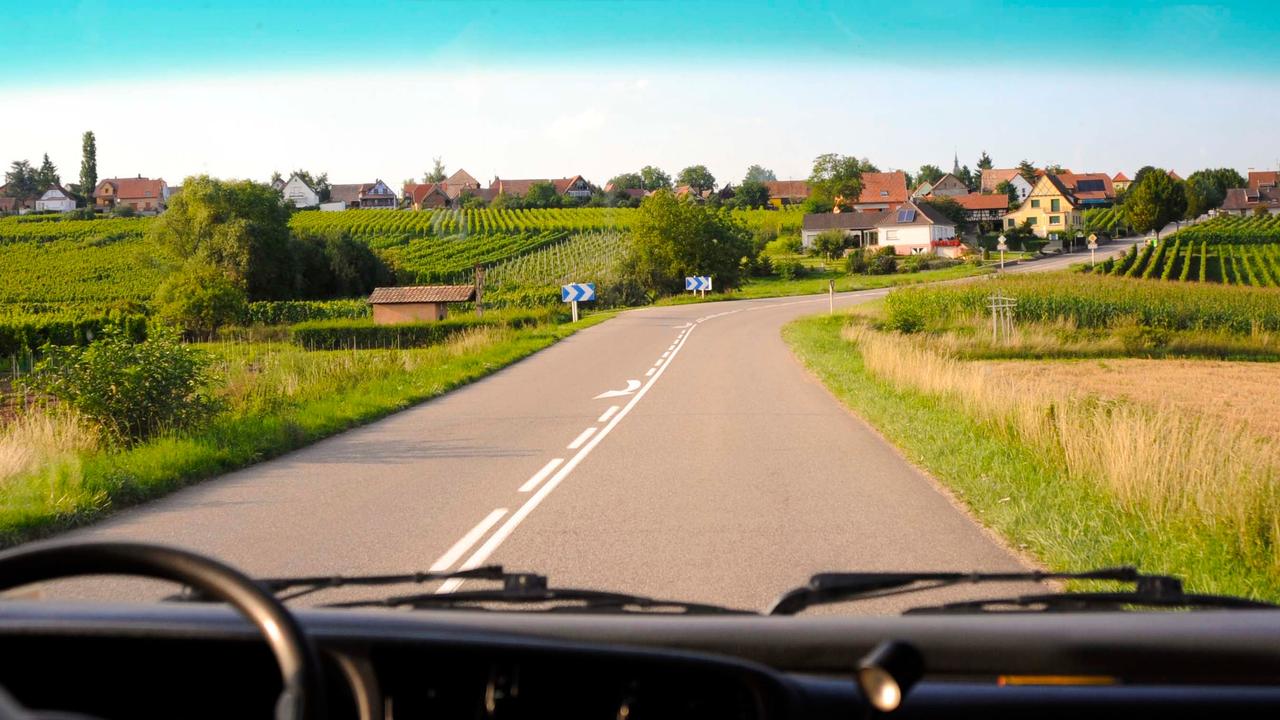
Unless explicitly stated, you must drive on the right in France. When overtaking, do so on the left.
On hills, the vehicle driving down should give priority to the vehicle coming up. That’s the theory, anyway.
You must give way to emergency service vehicles when their sirens are on – just like in the UK.
Seat belts must be worn by all occupants of a vehicle.
Speed camera detectors and jammers are banned in France, and you must turn off such warnings in your car or phone if applicable. If you are found to be using speed camera detectors – even on Google Maps – you could be fined €1,500. You are also prohibited from warning other drivers about the location of a speed camera.
Using earphones or in-ear Bluetooth devices is illegal, and can result in a fine of €135 (£115).
Children aged 10 or below must travel in an appropriate car seat – just like in the UK. This does not apply for taxis or cars without seatbelts.
The drink-drive limit is lower than in the UK – 50 milligrams of alcohol per 100 milliliters of blood, compared to 80 milligrams in the majority of the UK. For newly qualified drivers and bus drivers, it’s 20 milligrams in France. Random breath tests are more common in France than in the UK, so best not to risk it and stay on the zero-alcohol drinks if you’ll be driving.
Priorité à droit
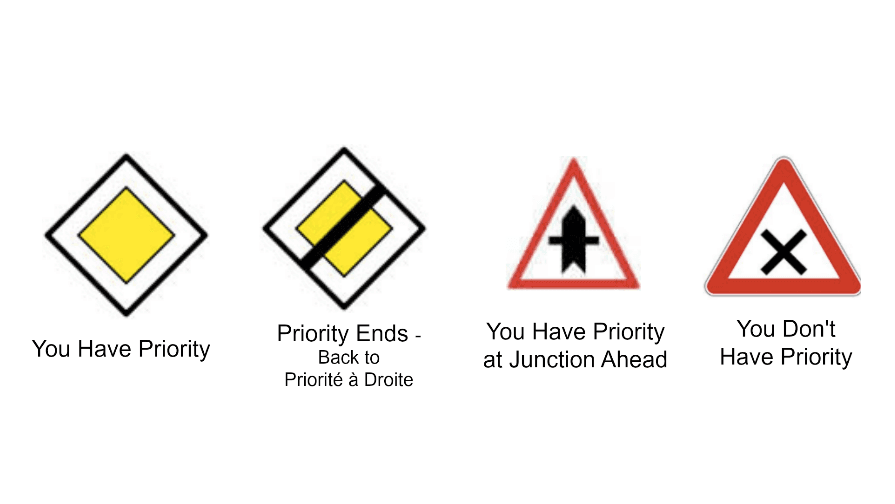
At main intersections and at many junctions you will need to give way to the left.
However, you may come across some junctions that are 'priorité à droit', which means you need to give way to vehicles approaching from the right. Usually, these will be in smaller areas but, if a junction is unsigned, assume priorité à droit is in place and take extra care in case a car is coming from the right.
Speed limits
Speed limits are measured in kilometres per hour (km/h) rather than miles per hour like in the UK. In built-up areas, the speed limit is usually 50km/h (31mph). On motorways, the limit is usually 130km/h (80mph) in good conditions and 110km/h (68mph) when it’s raining. Always look out for signage that tells you if the speed limit is lower for that particular area.
On motorways, there is a minimum speed limit of 80km/h if you are using the ‘fast’ lane. Be aware that most modern cars will let you swap the speedometer from mph to km/h and back.
You may come across French community speed enforcement groups. We get these in the UK as well, but there’s a difference in France – the police can actually prosecute you based on the results from a community speed enforcement group.
There are also a number of private radar cars on French roads – basically a speed camera in an unmarked car.
Oh, and don’t get sucked into the trap of going faster because you’re being tailgated by a Frenchman late for his lunch – don’t risk your licence.
French road signs
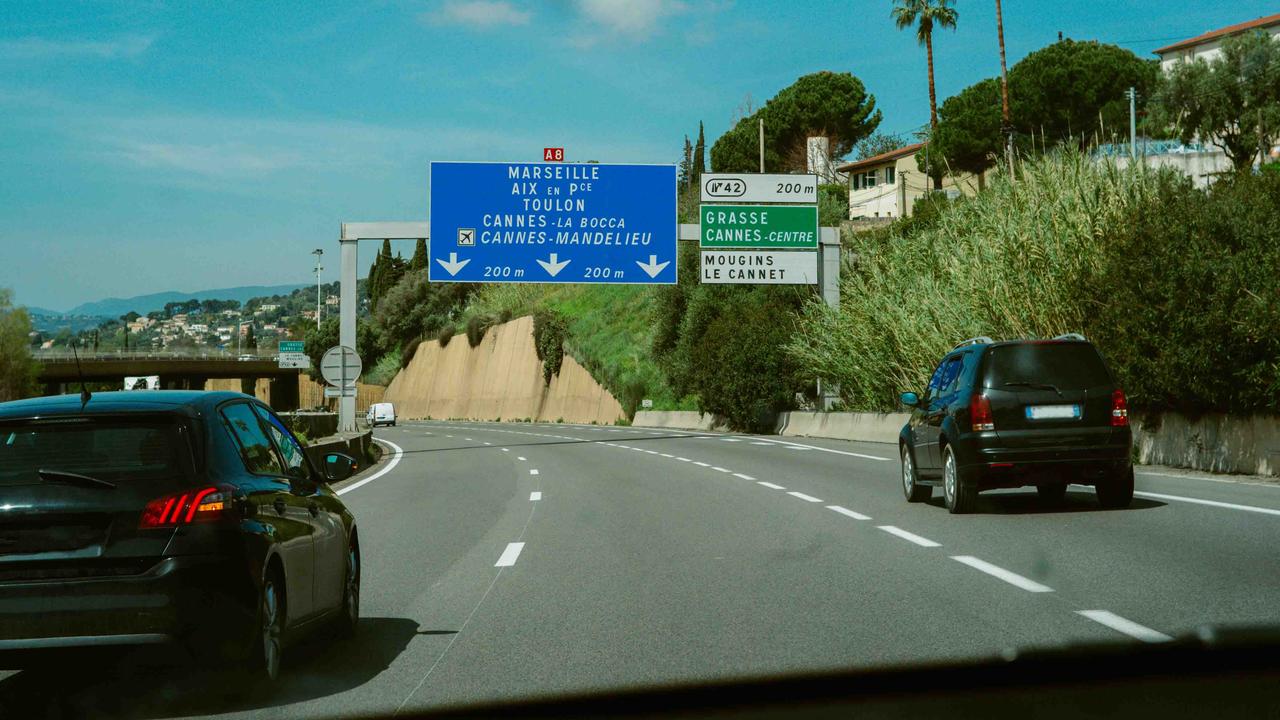
Priorité à droit junctions may be unmarked or may be marked with a red triangle sign featuring a black X. If there’s no sign, it’s probably priorité à droit.
The French also use ‘give way’ signs like those in the UK, with the words ‘cedez le passage’ beneath.
On roads with a yellow-and-white diamond sign, you have priority over other traffic.
As in the UK, triangular signs are for warnings and circular signs are laws.
Distances are measured in kilometres and metres.
| French road signs you may come across | English translation |
| Allumez vos feux | Turn your lights on |
| Zone circulation restreinte (ZCR) | You’re entering a restricted driving zone (for vehicle emissions – more info below) |
| Halte – péage | Stop at the toll booth ahead |
| Halte – police/gendarmerie | Stop at the police checkpoint ahead |
| Sens unique | One way |
| Travaux | Roadworks |
| Fin de chantier | End of roadworks zone |
| Rappel | Reminder |
| Route barre | Road closed |
| Déviation | Diversion |
| Toutes directions | All directions |
| Autres directions | Other directions |
| Passage piétons | Pedestrian crossing |
| Chaussée glissante | Slippery road |
| Le sens interdit | No entry |
| Bis (then destination) | Alternative or scenic route |
| Interdit sauf | Prohibited except (what’s depicted on the accompanying picture) |
Emissions stickers and low-emission zones
If you’re visiting a major town or city in France, you’ll likely need a Crit’Air vignette to drive in French low emission zones (ZCRs). And you need to have it displayed in your car before you go – so you’ll need to factor in a few weeks for the sticker to arrive.
There are six Crit’Air sticker categories, based on the level of pollution your car emits – 1 being the least and 5 being the highest. E, or 0, is used for zero-emission vehicles such as electric cars. Depending on how polluting your car is and where you’re travelling to, you may not be allowed into city centres between certain times. For example, you’re not allowed to drive in Paris between 8am and 8pm Monday to Friday if your Crit’Air sticker is higher than 1.
An emergency low-emission scheme runs pretty much nationwide. These ZPA areas require you to display a Crit’Air vignette when public announcements say so.
Make sure to buy your sticker from the official Crit’Air website. In France, a Crit’Air sticker costs €3.81, but you’ll need to pay more for postage to the UK. You can’t buy it for a UK-registered car once you’re in France. A Crit’Air sticker lasts the lifetime of the vehicle, so you only have to buy it once per car.
Cars registered before 1997 are too old to have a Crit’Air sticker, meaning you won’t be able to drive in ZCRs while they’re operational.
Toll roads in France
France has a lot of toll roads and autoroutes. Generally, you’ll take a ticket when you enter the motorway (a bit like entering a car park) and pay when you reach the end of the toll road. Cash or card is usually accepted.
If you buy a toll tag before you go on holiday, then France’s Télépéage scheme lets you link your bank account so you can go through the fast lane and be billed automatically. Interestingly, electric cars typically get a 5% discount on the Télépéage scheme.
Electric car charging in France
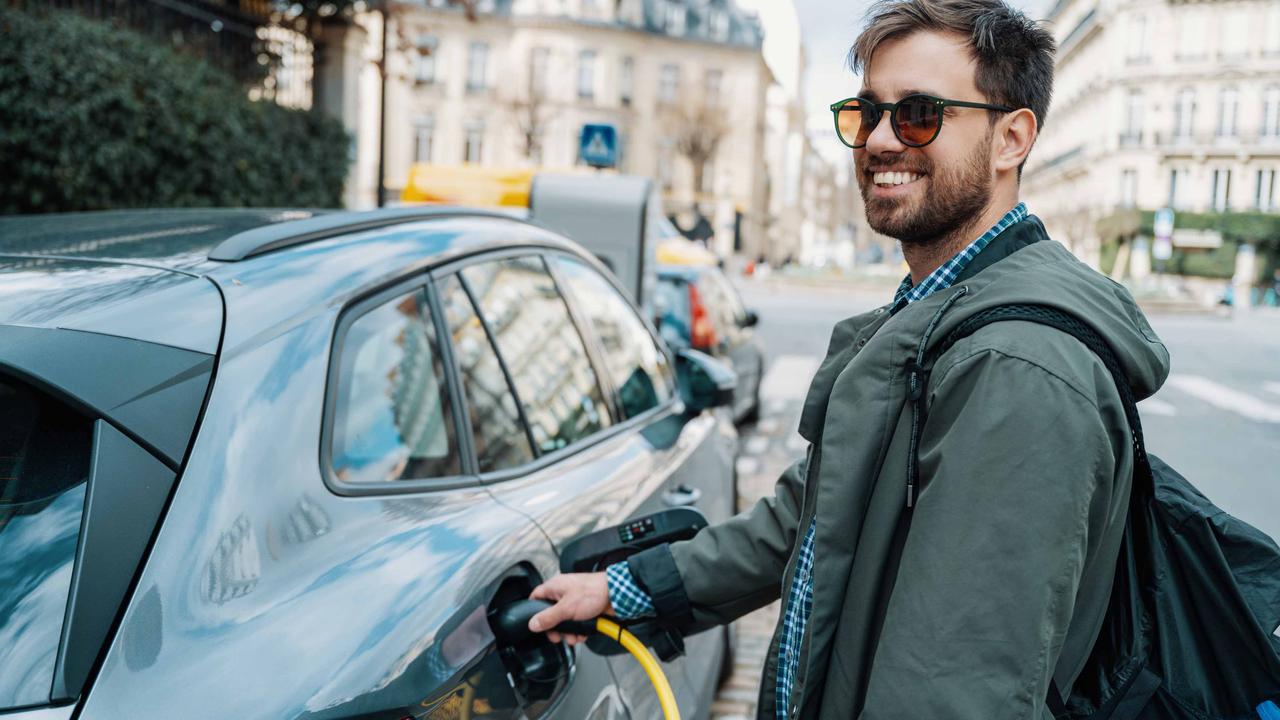
Taking your electric car to France shouldn’t be a problem – there are nearly 200,000 EV chargers across France, and they use the same connectors we use in the UK. As you might expect, they’re more common in high population areas – you’re unlikely to find a bank of rapid chargers in the sort of countryside that’d suit a Monet painting. An increasing number of campsites and overnight parking areas are having EV chargers installed for topping up your battery while you sleep.
Often, you may need to download an app to access a charging network, and the app or card may need to be pre-loaded before you can start charging.
You still need to display a Crit’Air sticker for electric cars.
Parking in France
On roads where cars are going both ways and parking is available, you must park on the right-hand-side of the road (in line with the flow of traffic). On one-way streets, you may park on either side if the road is wide enough.
Yellow lines on the side of a road mean you cannot stop or park there. Parking restrictions are also in place in areas with blue road markings.
Driving a UK car in France
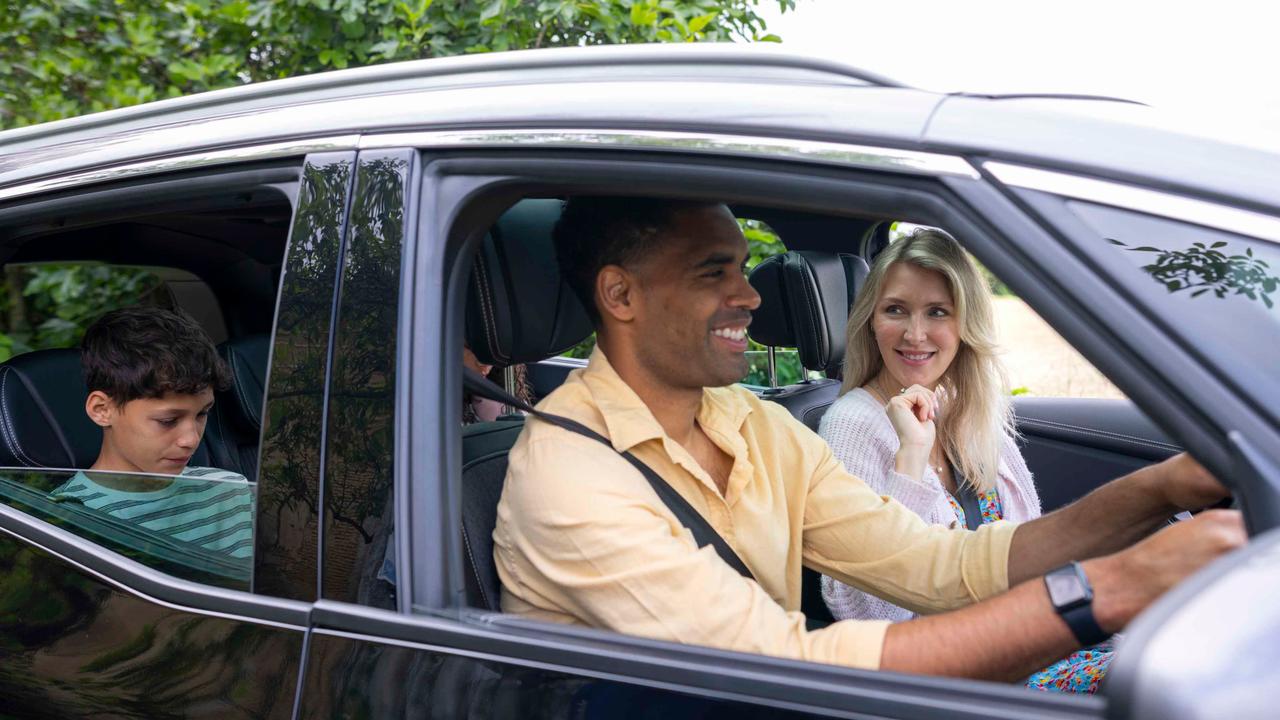
The main difference is driving on the ‘wrong’ side of the road to what we’re used to in the UK. You’ll need to remember that at roundabouts and intersections.
Overtaking on a two-lane road is going to be very difficult, as you cannot look past the vehicle in front to see if the road is clear. We’d recommend waiting until you reach a dual carriageway or motorway.
Cycling is very popular in France, and you should give cyclists 1.5 metres of space when overtaking. This could mean being stuck behind a peloton of cyclists for a considerable amount of time if the road isn't clear.
Toll booths, ticket machines and drive-thrus are set up for left-hand-drive cars, so may be difficult to access unless you have a front-seat passenger.
Motorway service stations are usually available 24 hours a day, and rural petrol stations are increasingly being automated so you can use them through the night. You can pay with your UK debit or credit cards – just remember to tell your bank you’ll be away or they might freeze your card if you try to use it abroad! Fuel stations can be few and far between in rural areas.
Emergency phones are located roughly every 2km on the motorway network. Or dial 112 on your phone for the emergency services.
It’s often banned to use your horn in urban areas between sunset and sunrise.
Towing in France
You are only allowed to tow a vehicle with a rope if the towed vehicle has broken down – and you are not going far. On motorways, you cannot rope-tow at all, and a recovery vehicle must be organised. Because French motorways are privately owned, you’ll need to pay a fee to get towed away (this can usually be reimbursed if you have European breakdown cover).
A-frames are not allowed so, if you’re planning to tow a car with a campervan, it must be towed on a trailer. Trailers weighing over 750kg must have their own brakes, like in the UK.
Car-and-caravan combinations must not exceed 18.75 metres in length, and 2.55 metres in width. Campervans on their own must not be longer than 12 metres.
Speed limits for towing vehicles are generally the same as regular cars, provided that the combination of car and trailer weighs under 3,500kg.
Hiring a car in France
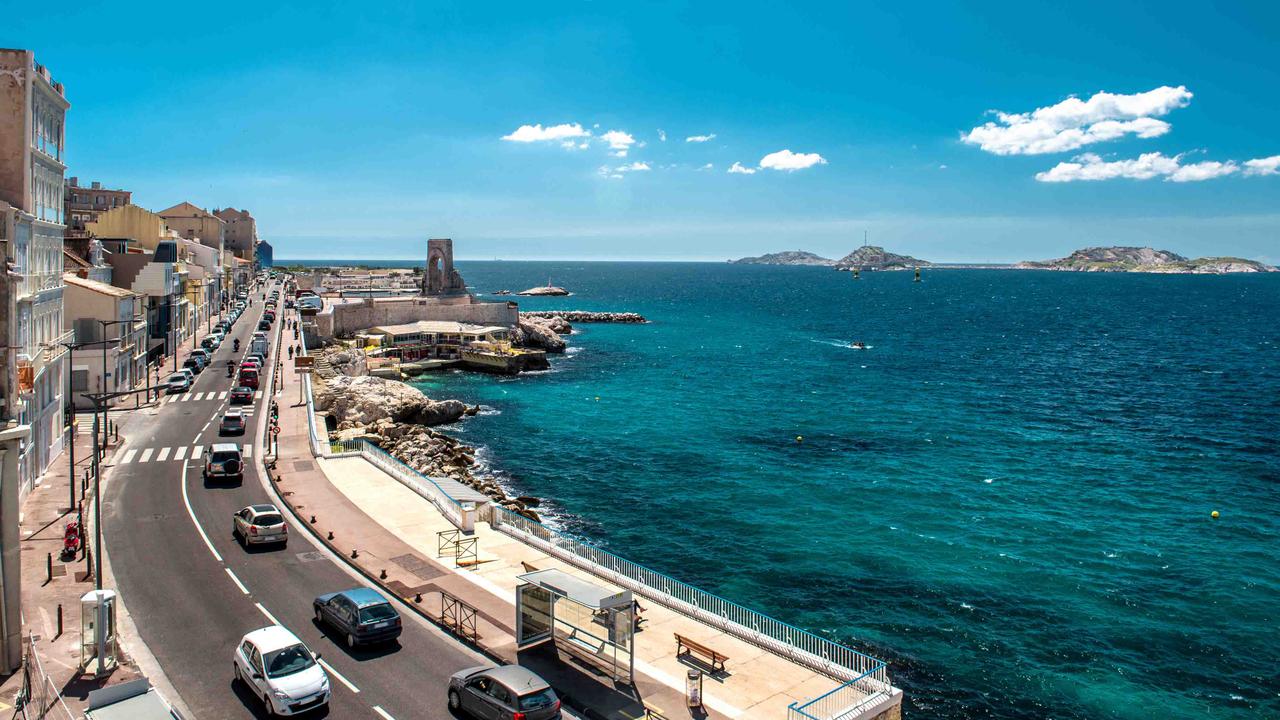
You’ll need to be at least 21 years old to hire a car in France, although some hire car companies might stipulate that you need to be 25 or older. Generally you’ll need to have held your licence for at least a year.
You may need to pay a deposit on a credit card. You may be limited to driving in France – check if you can drive in other countries if you’re planning to.
Take out hire-car excess insurance before you travel – it’ll be much cheaper than at the car hire desk.
If hiring a car with young children, it’s best to take your own child seats if possible. You won’t know about the availability or condition of child seats for hire until you get there – and they’ll be expensive.




































